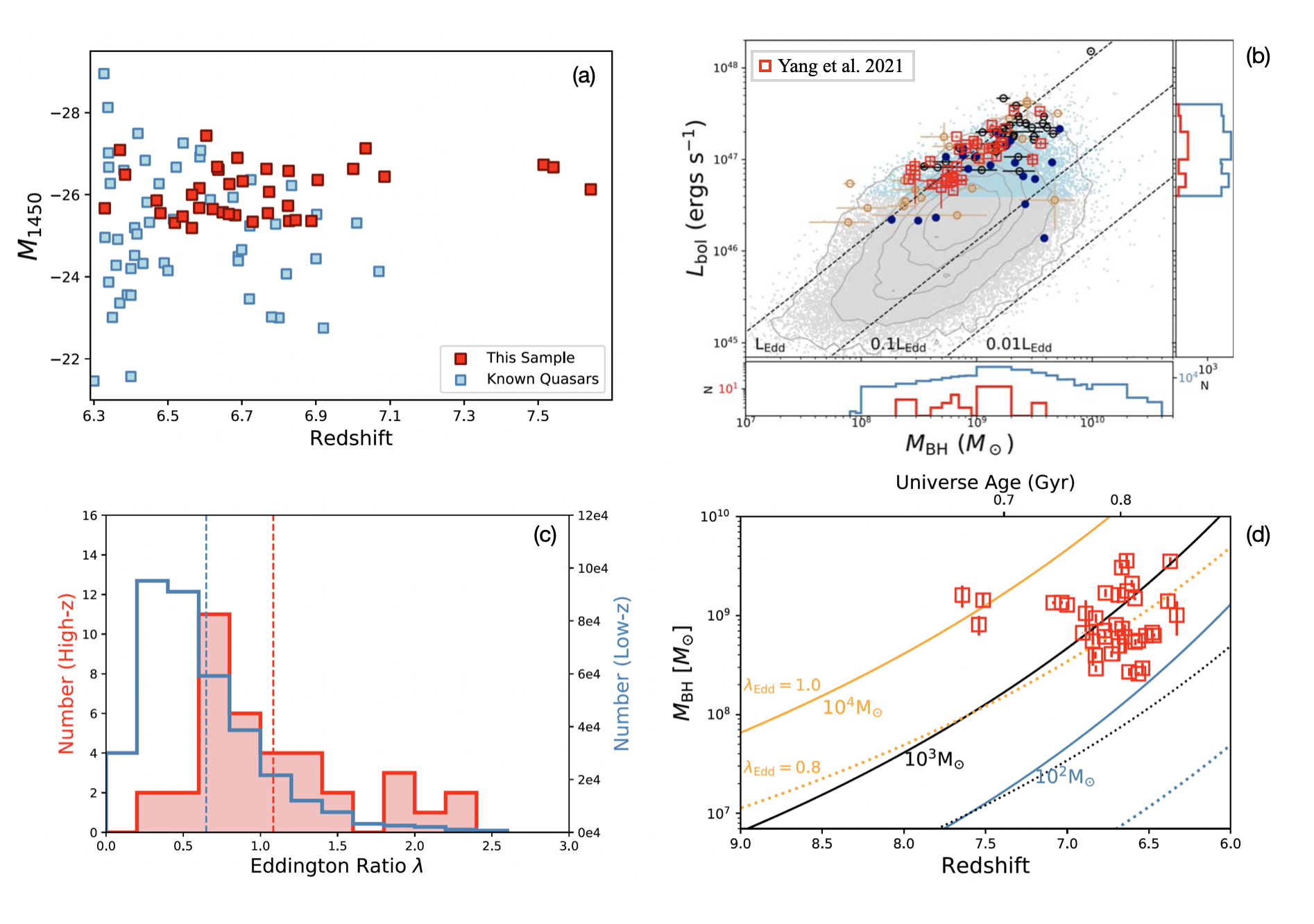Early SMBHs and Quasar UV Properties

Figure (a). The redshift and absolute magnitude distribution of quasars in our sample (red squares) and other known quasars at z>6.3 (blue squares). This new NIR spectroscopic sample covers 37 quasars from redshift 6.35 to the most distant known one at z=7.64, which forms the largest NIR spectral dataset for quasars at z>6.5.
(b). New measurements of the quasar bolometric luminosities and BH masses of our sample (red open squares), compared with measurements of z~6 quasars in the literature and the SDSS lower redshift sample, estimated based on the same BH mass estimator. The light blue dots represent a luminosity-matched sample selected from the SDSS lower redshift sample. The histogram towards the right shows the luminosity distributions of the luminosity-matched low-redshift sample (blue) and our sample (red). The bottom histogram shows the BH mass distributions of the low-redshift sample (blue) and our sample (red).
(c). The distribution of Eddington ratios (λ = L_bol/L_ Edd) measured from quasars in our sample (red), compared with the luminosity-matched low-redshift quasar sample described above (blue). The Eddington ratios of quasars in our sample peak at λ ~ 0.8 and have a mean of 1.09 (red dashed line), while the low-redshift sample has a mean Eddington ratio of 0.65.
(d). BH mass measurements (red open squares) obtained from our quasar sample compared with the BH growth tracks with different seed BH masses. The three solid curves represent the BH growth tracks with seed BHs masses of 102 M_sun (blue), 103 M_sun (black), and 104 M_sun (orange), respectively, assuming Eddington accretion since z=30. The three dotted lines are the BH growth tracks with constant Eddington ratio λ_Edd=0.8. All these tracks are based on the assumption of a radiative efficiency of 0.1. Most of the quasars in our sample require massive seed BHs with masses ≳ 103 M_sun at z=30, and the three z=7.5 quasars require ≳ 104 M_sun seed BHs. A later starting time for BH growth, lower accretion rate, or higher radiative efficiency will result in a requirement of even more massive seed BHs. With λ_Edd=0.8, most of the quasars will need ≳ 104 M_sun BH seeds at z=30.
We are carrying out a near-infrared (NIR) spectroscopic surey of our new z ≳ 6.5 quasars. We have already constraucted a first sample of 37 quasars in a redshift range of 6.35 ≤ z ≤ 7.64, including 32 quasars at z ≥ 6.5, forming the largest quasar near-infrared spectral sample at this redshift. The spectra, taken with Keck, Gemini, VLT, and Magellan, allow the investigations of central black hole mass and quasar rest-frame ultraviolet spectral properties. The black hole masses derived from the MgII emission lines are in a range of 0.3-3.6 billion solar mass, which require massive seed black holes with masses ≳ 10^(3-4) solar mass assuming Eddington accretion since z = 30. The Eddington ratio distribution peaks at ∼ 0.8 and has a mean value of 1.08, suggesting high accretion rates of these quasars. The CIV-MgII emission line velocity differences in our sample show an increase of CIV blueshift towards higher redshift, although the evolution trend observed from this sample is weaker than the previous results from smaller samples at similar redshift. The FeII/MgII flux ratios derived from these quasars up to z = 7.6, compared with previous measurements at different redshifts, do not show any evidence of strong redshift evolution, suggesting metal enriched environments in these quasars. Using this quasar sample, we create a quasar composite spectrum (link) for z ≥ 6.5 quasars and find no significant redshift evolution of quasar broad emission lines and continuum slope, except for a blueshift of the CIV line. Our sample yields a strong broad absorption line quasar fraction of ∼ 24%, higher than the fractions in lower redshift quasar samples, although this could be affected by small sample statistics and selection effects.
• Yang, Jinyi; Wang, Feige;
Fan, Xiaohui, et al. 2021, ApJ Probing Early Supermassive Black Hole Growth and Quasar Evolution with Near-infrared Spectroscopy of 37 Reionization-era Quasars at 6.3 < z <= 7.64